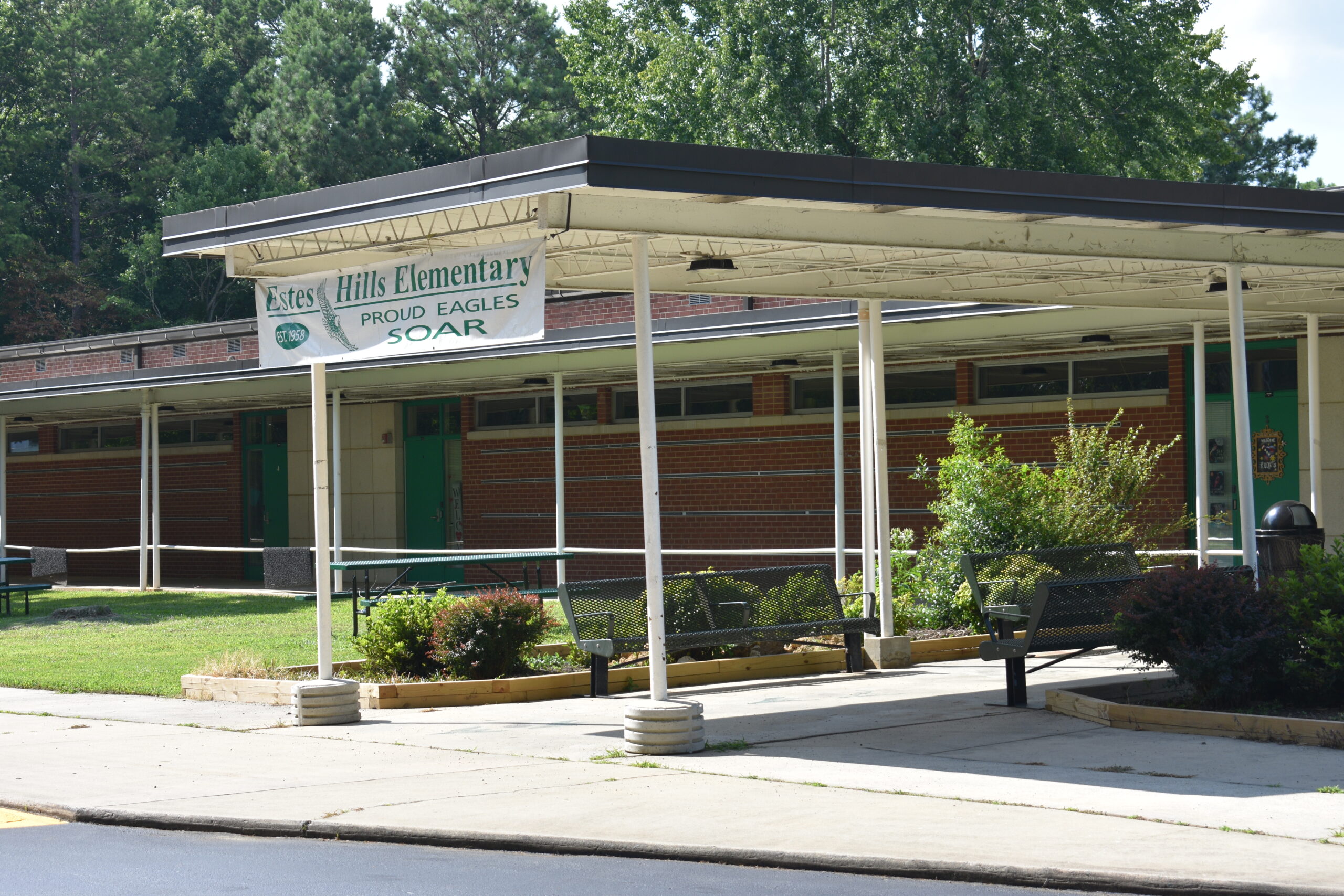A major school infrastructure bond referendum will be on the ballot for Orange County voters this fall. Between now and then, the local school districts are discussing exactly what development plans to pursue in order to best tell voters and Orange County commissioners which schools and buildings will benefit from the money.
Recently, Chapel Hill-Carrboro City Schools’ Board of Education heard its second presentation of a facilities plan and issued more guidance on what they which school projects like to prioritize. Deputy Superintendent of Operations Al Ciarochi shared more ten-year options for CHCCS Board of Education members to consider compared to the meeting on June 6.
The plan shared at that time, and with county commissioners the prior month, focused on pushing long-term solutions to the district’s most drastic school maintenance needs. That presentation circulated the community and drew both criticism and confusion, though, and Ciarochi clarified on Thursday that it was simply the most extreme example based on the Woolpert study done in 2023.
“The optimized plan, ultimately, did not really incorporate any of the values that you as a board or the community took into consideration,” he said. “It was strictly about putting kids into the newest facilities at the least amount of cost.”
This time, Ciarochi returned with additional paths the district could follow if a $300 million school development bond passes this fall. CHCCS would receive around $174 million, which could cover the replacement of three schools. But, as Ciarochi said, determining which three schools — and what to do with the affected students — in the meantime is a difficult balance.
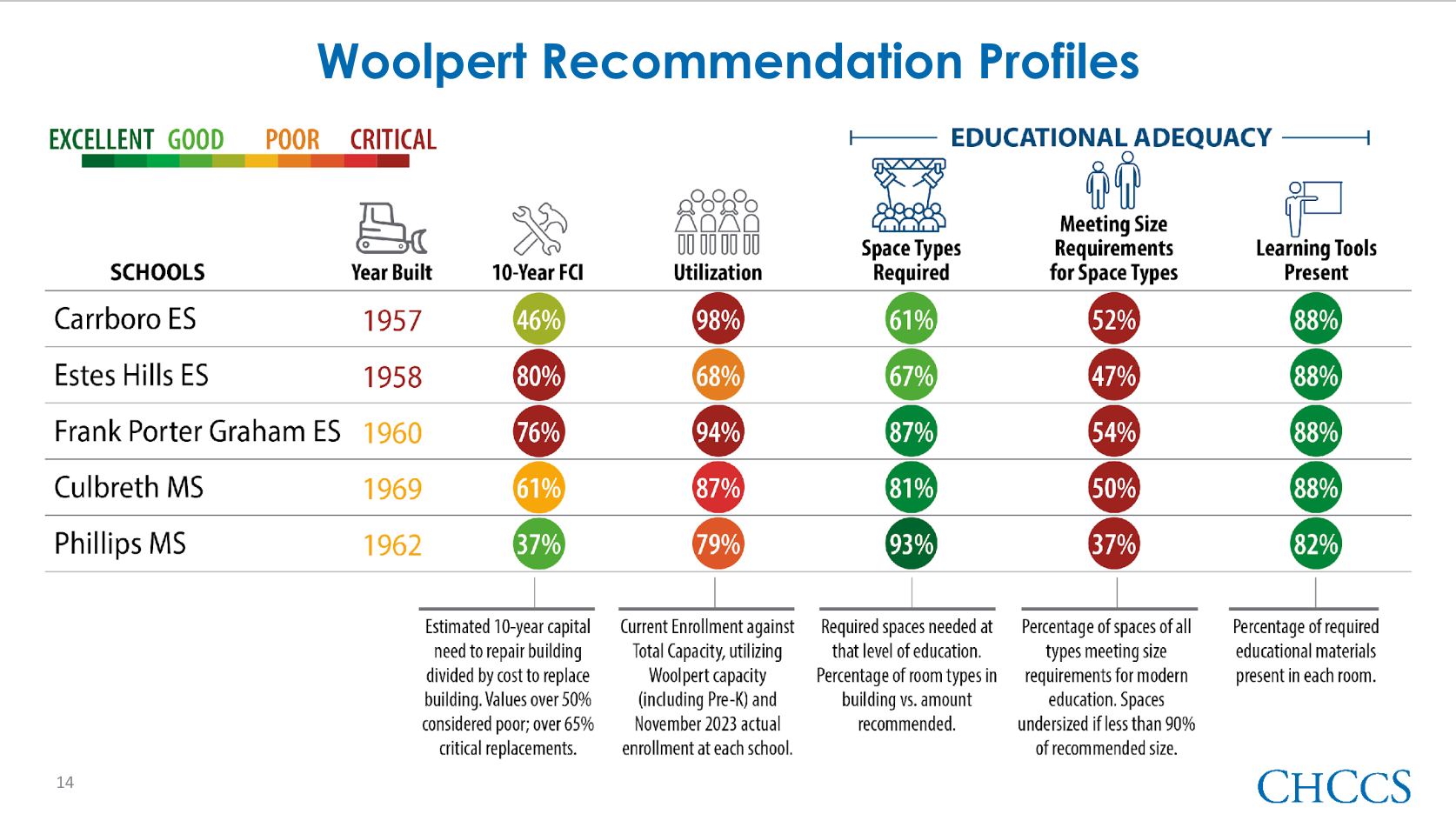
A graph of the higher priority schools listed in the Woolpert study to be considered for replacement. The Orange County Commissioners determined in their bond framework that some funding will be required to go toward improvements or replacements of Carrboro Elementary School and Culbreth Middle School. (Photo via Chapel Hill-Carrboro City Schools.)
Four main options that include construction of two elementary schools and one middle school were shared with board members, prioritizing schools with the worst facility condition scores and educational adequacy – specifically, size requirements based on space within the building. In each variation, Frank Porter Graham Elementary School would see its students and staff moved elsewhere, as two options included consolidating the district’s dual language programs to one campus while the other two would build space just for FPG students. Replacing Carrboro Elementary School and Culbreth Middle School were also among three of the four options, as the Orange County Commissioners and a third-party study identified those campuses as in significant need.
“It’s been a cumulative piece,” said Ciarochi, “and we’ve done our best to provide you with scenarios that we believe are viable solutions – that could be accomplished.”
Ultimately, the school board told Ciarochi and his staff they prefer two paths that could: build a new facility on land adjacent to Morris Grove Elementary School for current Frank Porter Graham Elementary students; replace Carrboro Elementary School; and replace Culbreth Middle School. With the FPG Elementary campus vacated, the students from Carrboro Elementary and Culbreth Middle could each use that building as a “swing space” over the years their new facilities would be built.
The difference in the options would be whether to consolidate all dual language programs at Morris Grove Elementary or only build a replacement for FPG Elementary on the land north of Chapel Hill and Carrboro. If consolidated, around 800+ students in the program would move into the current Morris Grove building — which would also likely receive an expansion. Students attending comprehensive elementary school classes would be reassigned elsewhere in the district, but only after construction on the new facility is complete. If the dual language program is not consolidated, a new facility on land nearby to Morris Grove Elementary would be built for the few hundred students who attend FPG Elementary.
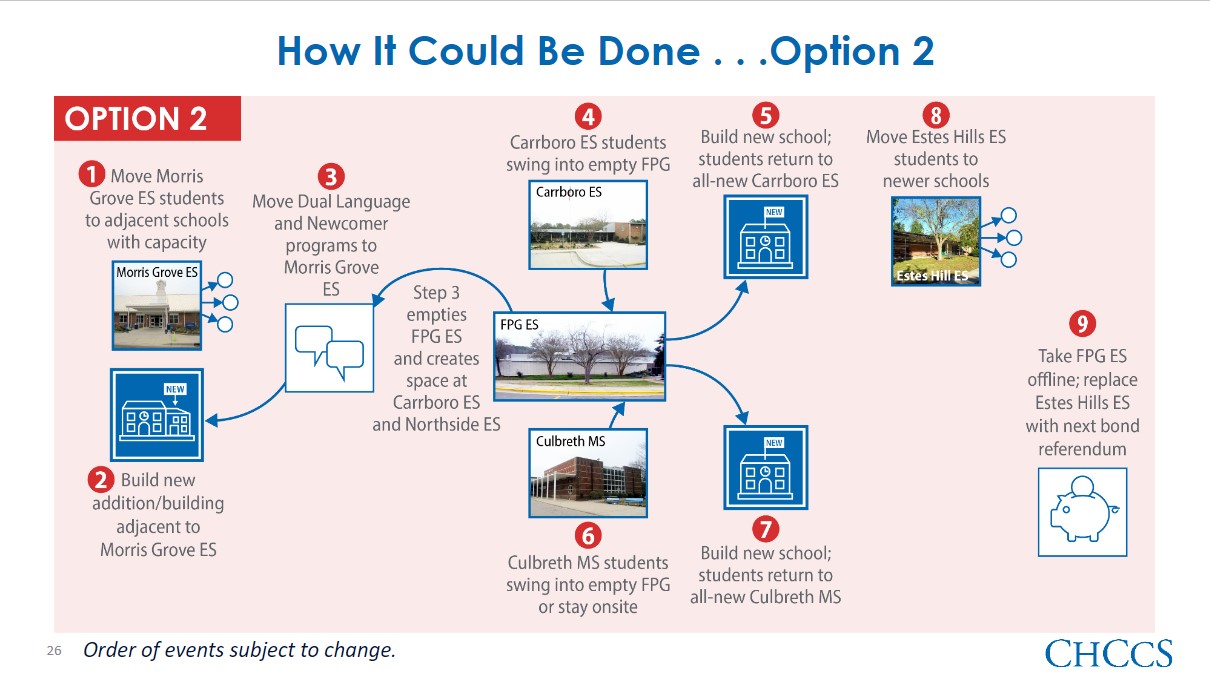
Option 2 of a facilities development and student relocation plan if the fall bond referendum passes, as presented to CHCCS board members on June 20, 2024. Morris Grove Elementary is identified as a space for a new facility based on the land deeded to the school district by the Orange County government. (Photo via Chapel Hill-Carrboro City Schools.)
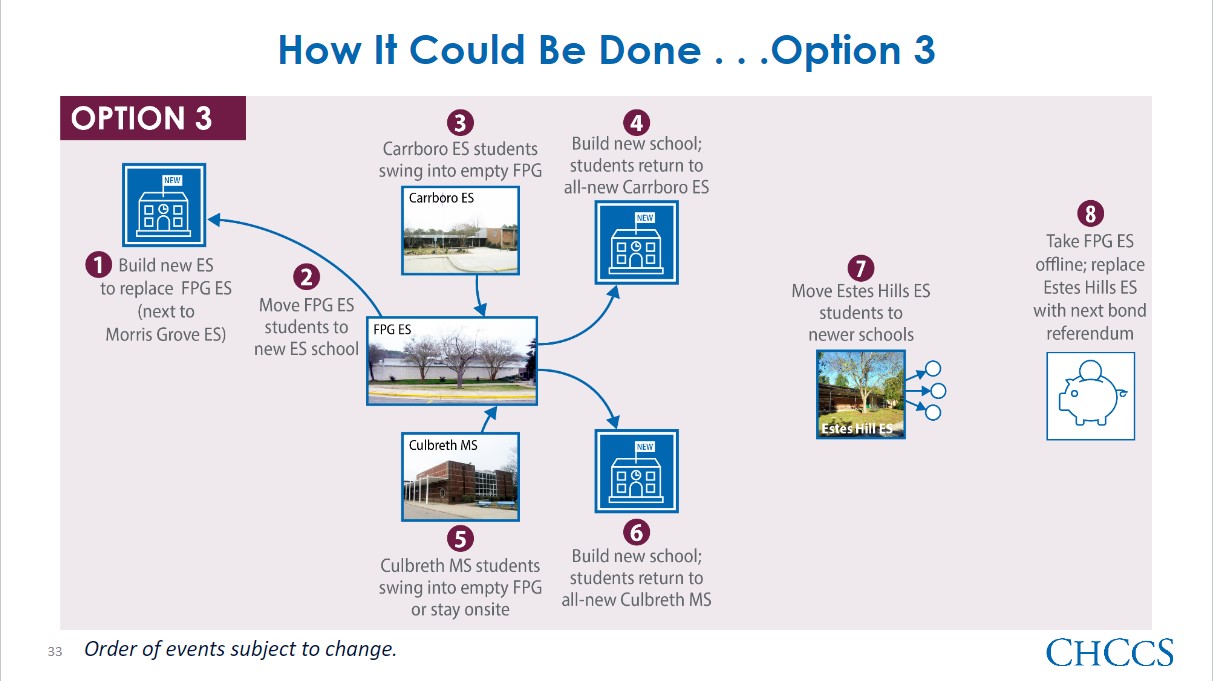
Option 3 of a facilities development and student relocation plan if the fall bond referendum passes, as presented to CHCCS board members on June 20, 2024. (Photo via Chapel Hill-Carrboro City Schools.)
Board Member Riza Jenkins supported these options because she listed the other two as creating too many transportation challenges for students and the district staff. She said she wants to keep walkability for families in mind during this process – one of the key criteria shared by some school parents during early discussions around the bond plans. Jenkins also specifically voiced her support of prioritizing Carrboro Elementary School’s replacement.
“I mean, I didn’t realize Carrboro was part of the old bond plan,” she said. “It was in line next as a school [for replacement], so I don’t want to lose that either. I don’t want to keep kicking plans down the road.”
Vickie Feaster Fornville, meanwhile, shared her memories of having to move elementary schools four times based on a combination of one move with her family and two rounds of redistricting. Drawing from that experience, she said she wants to prioritize options that require as little impact on student movement as possible.
“I understand what that looks like and what that feels like,” said Fornville. “When we can have the most bang for our buck with the least impact, I think that’s important. I also think we need to look at how much marginalized students have to get pushed around, in terms of going from school to school – [because] historically in our district, that has been done over and over again.”
With the two remaining options, though, there is also a “wild card” option to rope in two other schools. In each option Ciarochi shared with the board members, Phillips Middle School was included as a potential replacement substitute for Culbreth Middle School – with the deputy superintendent identifying Estes Hills Elementary’s site as the future place for a new middle school before building a new elementary school within Phillips’ current footprint. Ciarochi added that by choosing options that do not build a middle school near Morris Grove, the money saved could be spent on costly projects that would boost Culbreth’s condition.
“With that option,” he said of building a new Phillips Middle, “there is money you can continue to invest in Culbreth knowing that you swapped it out from replacing it to a high-impact renovation… You are contributing [to improvements.]”
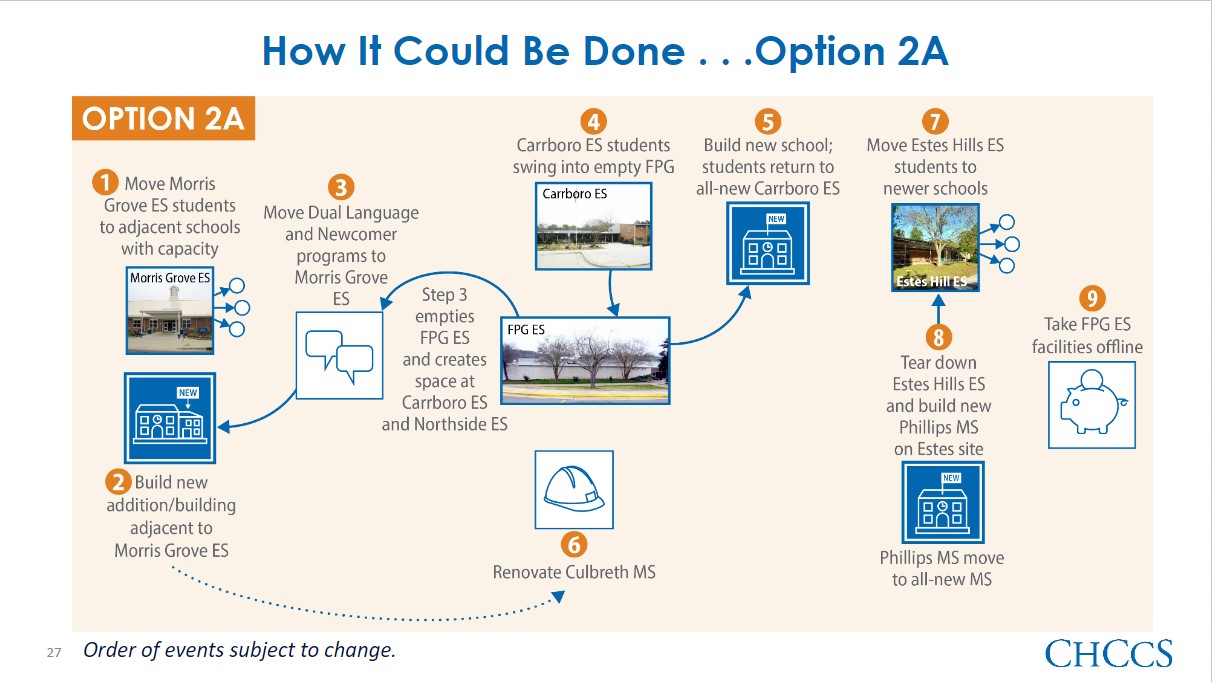
The alternative Option 2, which includes funding the replacement of Phillips Middle School and using extra funds for high-cost renovations at Culbreth Middle School. (Photo via Chapel Hill-Carrboro City Schools.)
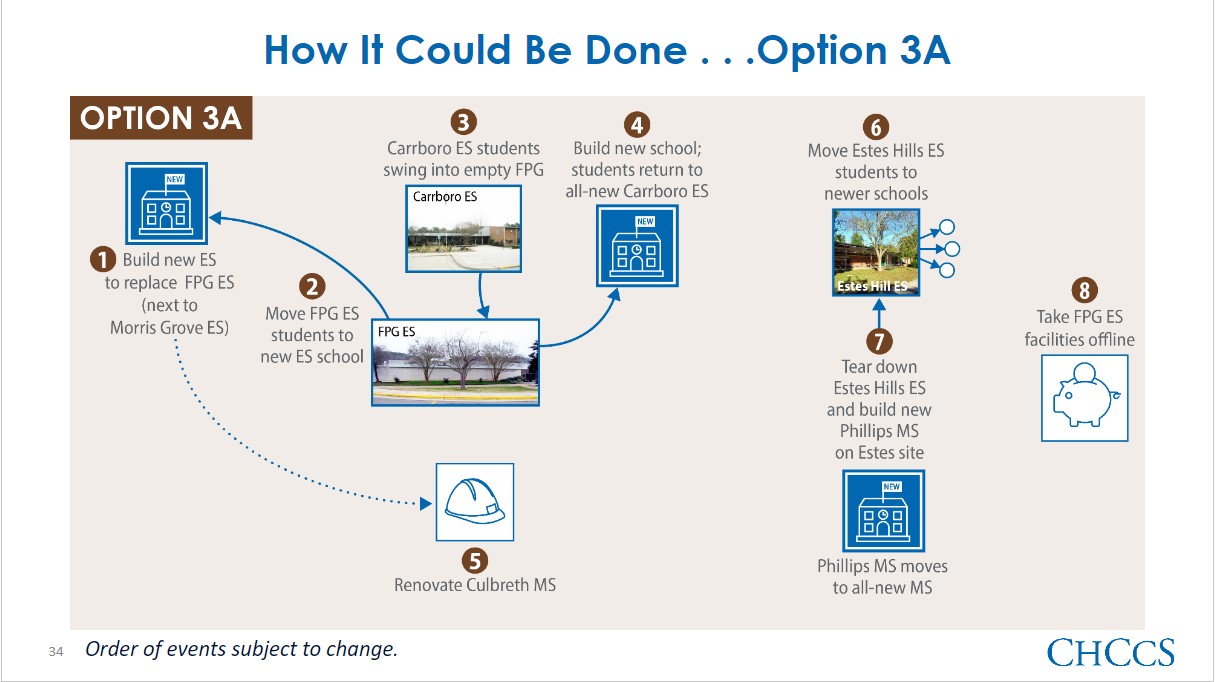
The alternative Option 3, which includes funding the replacement of Phillips Middle School and using extra funds for high-cost renovations at Culbreth Middle School. In this option, the dual language programs in the district would not be consolidated to one campus. (Photo via Chapel Hill-Carrboro City Schools.)
Board Member Meredith Ballew brought up Estes Hills Elementary in her comments because the reassignment of its students is included at the end of each presented option – a topic which has been at the center of local controversy around the facilities plan. Some families were concerned about the school being closed entirely, while others were concerned about it not being prioritized for replacement.
Ciarochi affirmed in his presentation that Estes Hills has “never been in our thoughts to ever [permanently] close.” But he added that Estes Hills Elementary plays a critical role in future school replacement and is a replacement candidate itself, simply because it is school-owned land next to an operating middle school that will also need replacement in the next two decades. The building also has some of the worst facility condition and educational capacity scores, and with slowing enrollment, other elementary schools could temporarily absorb its student population easier than others.
Ballew – who herself is an Estes Hills alumna – asked if there was a way to try and work toward certainty in the school’s future role for the district, specifically asking to ensure students are not reassigned in the next decade for an indefinite period of time.
“What can we do,” she said, “to show good faith that we’re going to rebuild that community’s school?”
“I think a powerful message,” responded Ciarochi, “if it pans out in that direction, is the replacement of Phillips [Middle School.] It’s starting the commitment, instead of just saying ‘trust the plan’ [ten years from now.]”
The CHCCS Board of Education will hear from Ciarochi on the facilities plan again during its meeting scheduled for July 18, where the two remaining options will have more details and any additional paths will be shared. Ciarochi’s presentation from June 20 can be watched here, with his presentation slides available here.
Chapelboro.com does not charge subscription fees, and you can directly support our efforts in local journalism here. Want more of what you see on Chapelboro? Let us bring free local news and community information to you by signing up for our newsletter.


